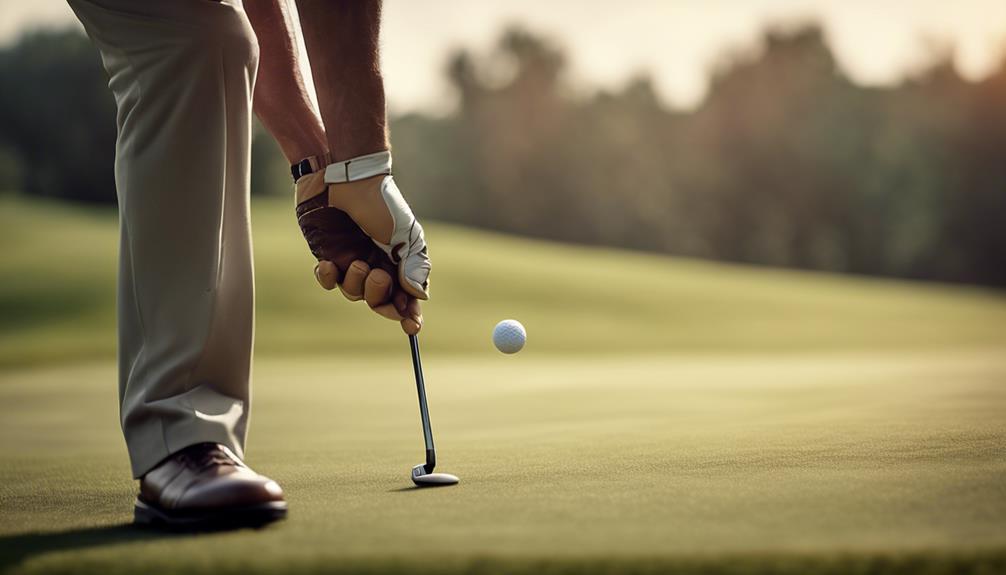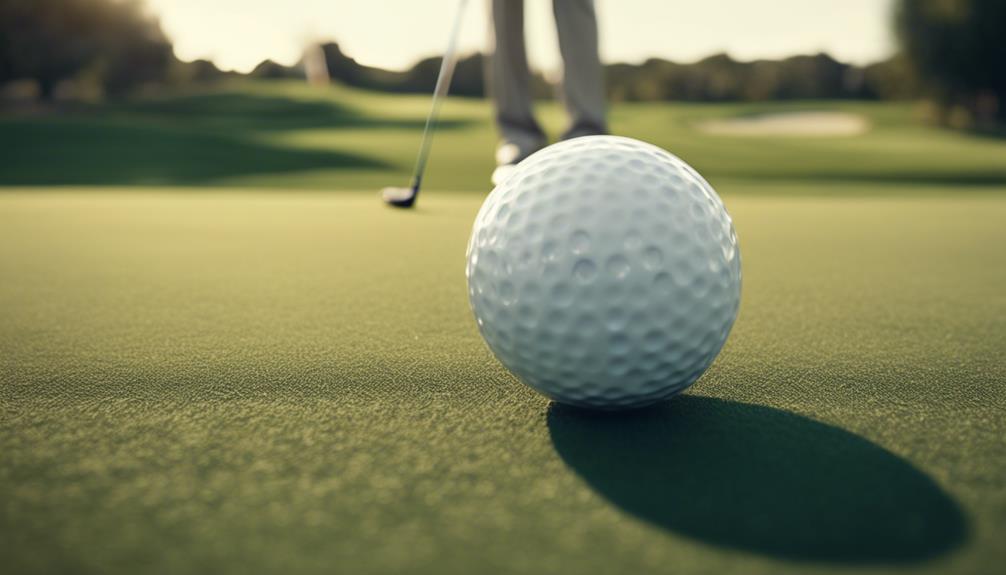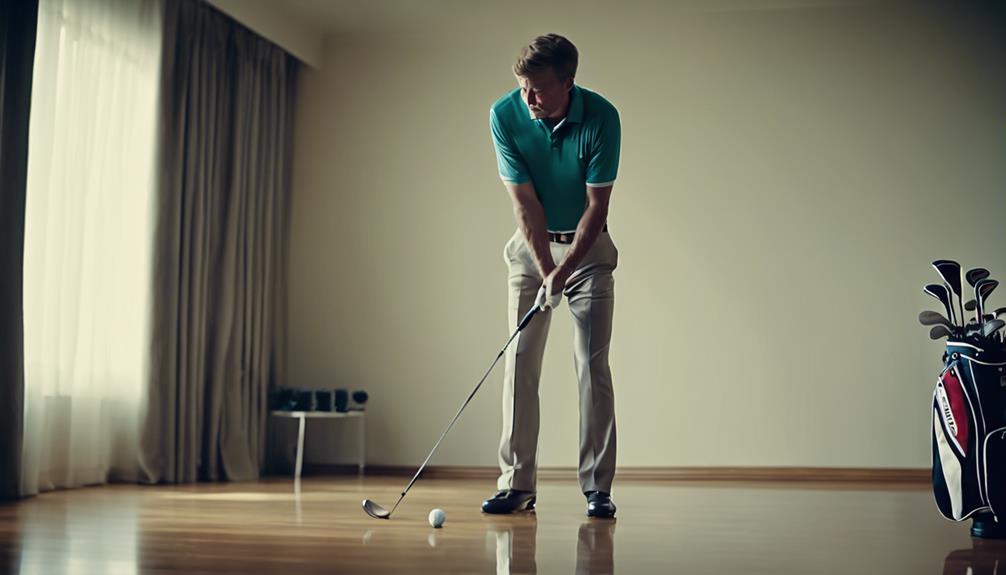- 7 Top Flite Golf Clubs XL for Improved Performance - September 28, 2024
- Top Flite Golf Clubs: Top 5 Reasons to Choose Them - September 28, 2024
- Top 3 Golf Club Fitters for a Perfect Swing - September 28, 2024
To determine if your golf clubs are left or right-handed, start by practicing with both types to see which feels more natural and comfortable. Pay attention to your natural rotation and balance, as this can indicate your dominant hand. Hold the club correctly, with your dominant hand at the top of the grip and the other hand at the bottom. Examine the club from your perspective, observing the hosel's angle and clubface direction. Take a few swings with both right and left-handed clubs to see which one feels more natural. You're on the path to revealing your ideal swing style, and there's more to discover about perfecting your game.
Key Takeaways
- To determine handedness, hold the club with your feet shoulder-width apart and the club head on the ground, observing the clubface direction.
- The hosel's angle indicates handedness: angled to the right for right-handed clubs and to the left for left-handed clubs.
- Hold the club in both hands to see which orientation feels more natural and comfortable, and practice swinging to develop a natural feel.
- Check the grip orientation: dominant hand at the top and other hand at the bottom, with the clubface direction aligned accordingly.
- Visual cues, such as the clubface direction and hosel's angle, can help distinguish between right- and left-handed golf clubs.
Identifying Your Swing Style
When it comes to identifying your swing style, start by determining your dominant hand, as this will profoundly impact your overall golf game.
To do this, try practicing with both right- and left-handed golf clubs to see which feels more natural and comfortable for you. Stand with your feet shoulder-width apart, with the ball closer to your front foot, and take a few swings with each club. Pay attention to your body's natural rotation and balance, as this can indicate which hand is more dominant and suitable for your golf swing.
As you're swinging the club, notice which hand takes the lead and guides the club through the motion. If you find that you consistently hit the ball more accurately and with more power with one hand, it's likely that's your dominant hand.
Adopting a proper golf stance and using the correct hand will help you maintain balance and generate more power in your swing. Don't worry if you're a left-handed player in a mainly right-handed sport – finding your natural swing style will make all the difference in your game.
Holding the Club Correctly
You'll need to grip the club correctly, with your hands positioned in a specific orientation to facilitate a smooth swing and maximum control.
When holding the club, your dominant hand should be positioned at the top of the grip, with your other hand at the bottom. For a right-handed golfer, the dominant hand is the right hand, and for a left-handed golfer, it's the left hand.
Hold the club with your feet shoulder width apart, with the club head resting on the ground.
The clubface direction is essential; for a right-handed club, it should point to the right, and for a left-handed club, it should point to the left. When holding a left-handed club, the hosel should be angled to the left, and for a right-handed club, it should be angled to the right.
By holding the club correctly, you'll be able to maintain a consistent swing and achieve the desired ball flight.
Make sure to practice your grip and stance regularly to develop muscle memory and improve your overall game.
Visual Cues for Handedness

To confirm you're holding the correct club, it's vital to recognize the visual cues that distinguish right- and left-handed golf clubs.
When determining handedness, it's necessary to examine your perspective as a golfer. Hold the club head on the ground or a flat surface, with the clubface directed towards you.
Observe the hosel's angle; if it's angled to the right, it's a right-handed golf club. Conversely, a left-handed golf club will have a hosel angled to the left.
This visual cue is key to identifying the club's handedness. Remember, when playing, you'll stand on the opposite side of the ball relative to the club's handedness.
As a right-handed golfer, you'll stand on the right, and as a left-handed golfer, you'll stand on the left.
Club Design and Orientation
As you examine a golf club, you'll notice that the club face direction, grip orientation, and shaft alignment are critical factors in determining its handedness.
These elements work together to facilitate a smooth swing and peak performance, so understanding how they interact is crucial.
Club Face Direction
When standing behind a golf club, its face direction is immediately apparent, with the clubface's orientation relative to your position determining whether it's designed for a right- or left-handed golfer.
To determine the handedness of a golf club, observe the clubface by setting the club head on the ground or a flat surface, with the clubface directed towards you.
The club face direction is determined by the golfer's perspective, where a right-handed golfer will stand on the right side of the ball and a left-handed golfer will stand on the left side.
If the hosel is angled to the right, it's a right-handed golf club, and if it's angled to the left, it's a left-handed golf club.
The club head attachment isn't specific to right or left-handed golf clubs, and can be attached to the shaft of the opposite handedness.
The club face direction is vital in determining the handedness of a golf club, as it affects the golfer's performance and overall game.
Understanding the club face direction is essential in determining your dominant side and ensuring a proper fit for your golf club.
Grip Orientation Matters
You'll find that grip orientation is a critical aspect of club design and orientation, directly impacting your ability to make consistent and accurate shots. The way you hold the club, with your dominant hand positioned at the top of the grip, affects the club head design and ultimately the handedness of the golf club.
| Golfer Type | Grip Orientation | Club Head Design |
|---|---|---|
| Right-Handed | Left hand at top of grip | Angled to the right |
| Left-Handed | Right hand at top of grip | Angled to the left |
| Neutral | Either hand at top of grip | Neutral or adjustable |
As a golfer, understanding grip orientation is essential in determining the correct handedness of a golf club. With the correct grip orientation, you'll be able to make more accurate shots and improve your overall game. For left-handed golfers, the club head design is angled to the left, while for right-handed golfers, it's angled to the right. By recognizing your grip orientation and dominant hand, you can confirm you're using the correct handedness of golf club, leading to better performance and results.
Shaft Alignment Importance
With your grip orientation established, the next critical component to examine in club design and orientation is the shaft alignment, which directly impacts the club head's direction and your ability to hit the ball accurately.
The shaft alignment is essential in determining the handedness of a golf club, as it affects the club head's direction.
A right-handed golf club will have a shaft that's angled to the right, while a left-handed golf club will have a shaft angled to the left.
The club head attachment to the shaft plays a key role in determining the handedness of a golf club.
The design and orientation of the shaft are fundamental components in determining the overall performance of a golf club.
Getting the correct shaft alignment is imperative for achieving desired results.
Modern composite shafts have three layers of fiber winding, adding substantial rigidity and performance, and are designed to produce specific results, such as higher or lower launch angles.
Determining Your Natural Swing

To determine your natural swing, you'll need to assess your hand dominance and experiment with holding the club.
You can start by taking a hand dominance test, which will give you an idea of which hand is more dominant in your daily activities.
Next, you'll want to hold the club in both hands to see which orientation feels more natural and comfortable for you.
Hand Dominance Test
Determining your natural swing in golf begins with a simple test: stand upright with your legs close together and ask a friend to give you a slight push from the back. The leg you use first to gain balance will indicate your handedness.
This test will give you a good idea of which hand is dominant, but it's not the only way to determine your handedness in golf.
To further determine your dominant hand, try the following:
- Practice swinging a club to develop a natural feel for the game, as this will help you determine which hand feels more comfortable.
- Take a few swings with both right and left-handed clubs to see which one feels more natural.
- Hold a club with the clubhead on the ground; if the grooves point to the left, it's a right-handed club, and if they point to the right, it's a left-handed club.
- Experiment with different grips and stances to see what feels most comfortable for you.
- Remember, your dominant hand in golf may not be the same as your dominant hand in other activities, so it's essential to practice and experiment to find your natural swing.
Hold the Club
You'll get a better sense of your natural swing by holding the club in a way that feels comfortable for you, which can be a significant indicator of your handedness in golf.
Stand behind the ball with your feet shoulder-width apart and hold the club with the clubhead on the ground. If the grooves point to the left, it's likely a right-handed club, and if they point to the right, it's likely a left-handed club.
Hold a club in each hand, with your arms straight and your hands in a neutral position. The hand that feels more natural and comfortable holding the club is likely your dominant hand.
Take a few practice swings, paying attention to which direction you naturally rotate your body and swing the club. This can help clear which side you're more comfortable swinging from. If the club might feel more natural in your right hand, it's likely your right side is dominant, and vice versa.
Acquiring the Right Clubs
When selecting golf clubs, it's essential that right-handed players ask for right-handed clubs to guarantee a proper fit, as clubs are specifically designed for right- and left-handed players. This verifies that the club's design and features align with your natural swing and stance.
To acquire the right clubs, consider the following:
- Check the club handedness: Hold the club with the clubhead on the ground; the grooves should point to the left for right-handed clubs.
- Try before you buy: Rent clubs at driving ranges to test different clubs and find the perfect fit.
- Inspect the putter: The smooth side should face left, and the hitting surface should be lofted slightly.
- Don't compromise on fit: Using the wrong handedness can affect your performance and overall game.
- Get the correct fit for mastery: Acquiring the right clubs is vital for improving your skills and achieving mastery in golf.
Practicing With the Correct Fit

Frequently, golfers overlook the importance of practicing with the correct fit, which is essential for developing a consistent swing and improving overall performance.
To determine your correct fit, you should practice swinging a club to see which hand feels more natural and comfortable. This will help you identify your dominant hand, a vital aspect of handedness in golf.
Try getting into a proper golf stance and taking a few swings with both right- and left-handed clubs to see which one feels more comfortable.
Using a club designed for the opposite hand can lead to an inconsistent swing and negatively impact your game.
Renting or buying golf clubs specifically designed for your handedness can help you practice with the correct fit and improve your overall game.
By doing so, you'll be able to develop a consistent swing, leading to better performance and a more enjoyable golfing experience.
Frequently Asked Questions
Which Way Do I Swing a Golf Club?
To determine which way you swing a golf club, focus on your golf stance, swing plane, body rotation, and clubface alignment; practice drills like alternating swings and mirror work to develop muscle memory and consistency.
What Is Left Hand Orientation on Golf Club?
Imagine holding a golf club with the club face directed towards you; a left-hand orientation means the hosel angles left, consistent with your grip style, shaft angle, and hand positioning, which ultimately influences your swing path.
Can Lefties Use Right-Handed Clubs?
As a left-handed golfer, you can use right-handed clubs, but be prepared for the Handedness Debate; Club Conversion requires Swing Adjustments, and you're an exception, a Lefty Exception, needing Reverse Fitting to adapt, but it's not the most efficient way to play.
How Do You Hold a Golf Club if You Are Right-Handed?
What's the secret to a perfect swing? You hold the club with a neutral grip style, placing your left hand at the top and right hand at the bottom, with fingers positioned to control the club face, wrists angled, and body stance aligned.
Conclusion
Determining your handedness is like finding the missing piece of a puzzle – it clicks everything into place.
With the right clubs in hand, you'll be sinking birdies in no time.
Remember, a proper fit is key to improving your game.
Practice with purpose, and your swing will become as smooth as a well-oiled machine.
Now, get out there and drive your way to golfing success!




